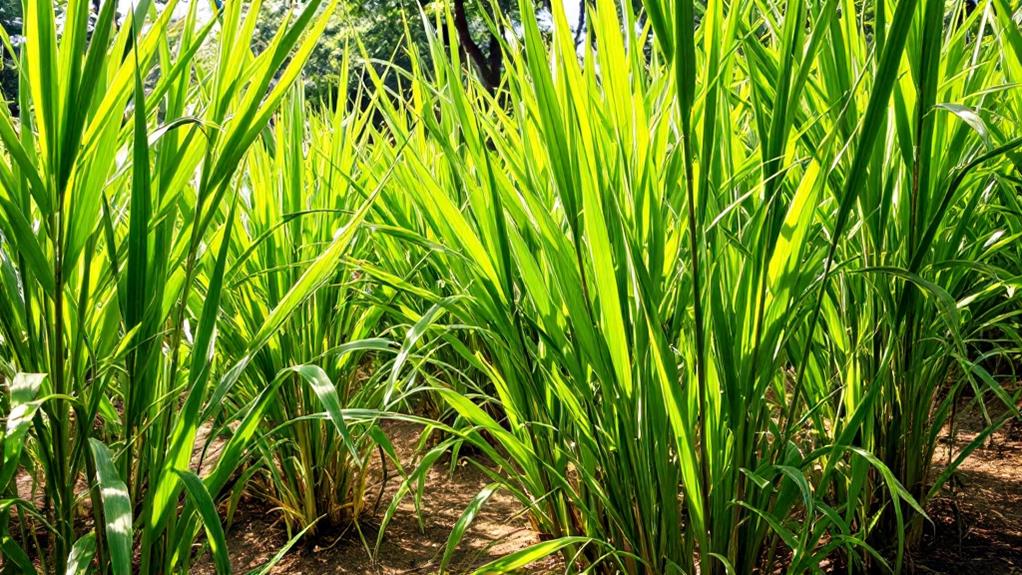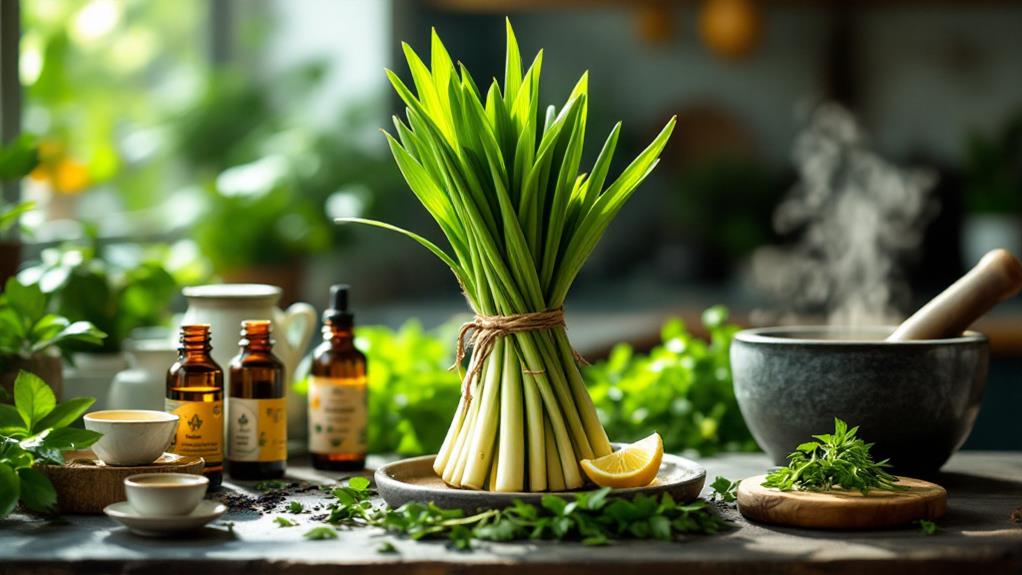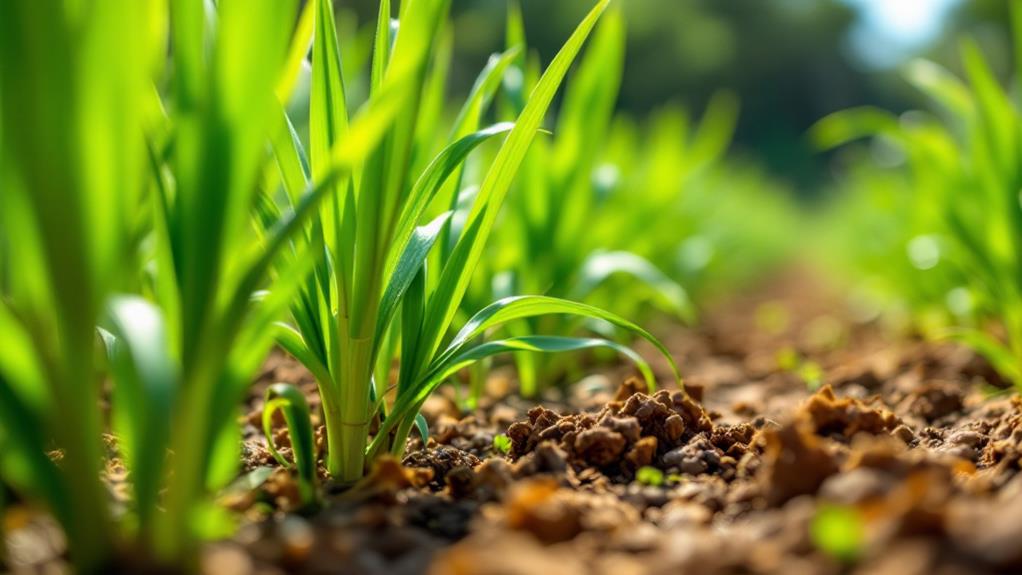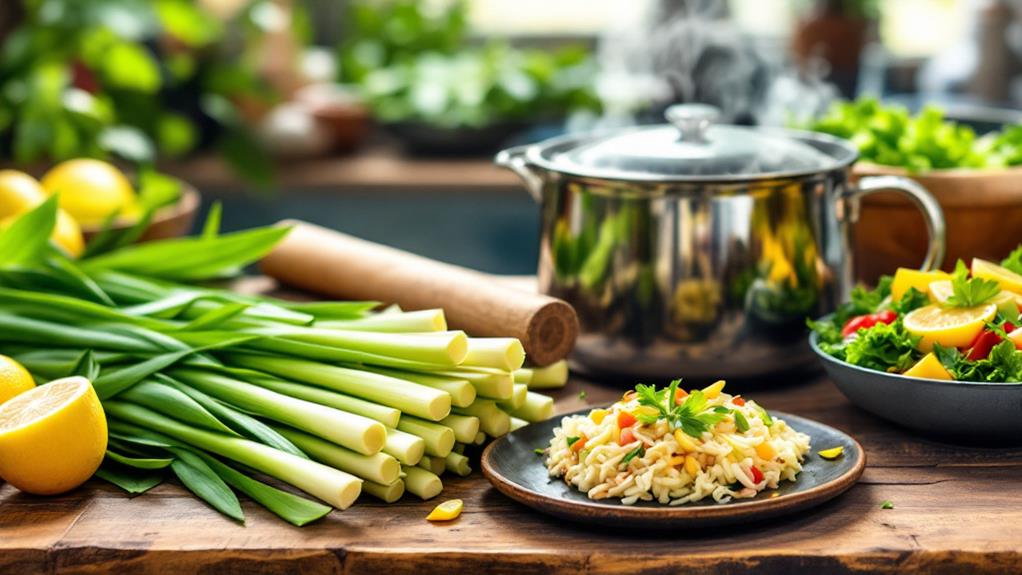Everything About the East Indian Lemongrass Plant: Health Benefits and Uses

You'll find East Indian Lemongrass, known scientifically as Cymbopogon citratus, thriving in tropical climates. Its oils, rich in citral and geraniol, offer potent antimicrobial and anti-inflammatory benefits. Incorporate it into your dishes or teas, and you'll enjoy improved flavors and support for digestive health. This versatile plant also aids in reducing anxiety, blood pressure, and more. Remember, though, concentrated oils can be risky if misused, especially during pregnancy. Lemongrass plays an essential role in sustainable agriculture as well, enhancing soil health while fostering biodiversity. There's so much more to investigate about this fascinating plant.
Overview of East Indian Lemongrass
East Indian lemongrass, scientifically known as Cymbopogon citratus, is a adaptable perennial grass that you'll find thriving in tropical climates. Native to these lush regions, it's a staple in both culinary and medicinal practices. It grows best in USDA Zones 8 and above, where full sun and well-drained loamy soil help it flourish. The plant is renowned for its crucial oils, rich in citral and geraniol, which are key to its aromatic and therapeutic allure.
You'll appreciate East Indian lemongrass for its assorted applications. In the kitchen, it's a favorite for infusing dishes with a invigorating, citrusy flavor, especially in Southeast Asian cuisine. Its culinary uses are vast, from soups to teas, making it an indispensable ingredient for incorporating zest.
Beyond the kitchen, lemongrass is prized for its medicinal purposes. Its crucial oils boast antimicrobial properties, offering a natural way to help address microbial concerns. It also exhibits anti-inflammatory and antioxidant properties, which can be beneficial for numerous ailments. Traditionally, it's been used to ease digestive issues, leveraging these properties for natural relief. Regardless of flavor or wellness, East Indian lemongrass is a valuable enhancement to your repertoire.
Health Benefits of Lemongrass
While lemongrass is a culinary delight, its health benefits are likewise impressive. Rich in anti-inflammatory compounds like chlorogenic acid and isoorientin, lemongrass can help you combat chronic inflammation, which is often linked to conditions like diabetes and heart disease. The vital oil of lemongrass contains citral, a compound that promotes vasodilation, potentially reducing blood pressure and offering calming effects. A 2022 review supports these findings, making lemongrass a great natural option for heart health.
Lemongrass also boasts potent antimicrobial properties. Research indicates that its vital oil is effective against Candida albicans, a common pathogen. This makes it a valuable ally in maintaining your complete health. Regarding digestive health, traditional practices have long accepted lemongrass, particularly in teas. Its high antioxidant content can help alleviate bloating and gas, enhancing your digestive comfort.
Moreover, if you're seeking to reduce anxiety, turn to lemongrass tea. A 2020 study in rats showed its potential in alleviating anxiety symptoms, suggesting it might offer comparable benefits for you. With these impressive health benefits, lemongrass is more than just a flavorful enhancement to your meals.
Common Uses and Applications

Lemongrass is a versatile gem in both culinary and therapeutic worlds. You can find East Indian lemongrass gracing many dishes, especially in Asian cuisines. Its citrusy aroma and taste make it perfect for flavoring soups, curries, and teas. Not only does it improve your culinary creations, but it also brings along impressive health benefits.
In therapeutic settings, the vital oil from East Indian lemongrass is a popular choice. Its soothing properties are harnessed in aromatherapy to promote relaxation and relieve muscle pain. The oil's antimicrobial properties make it effective against bacteria and fungi, consequently serving as a valuable component in natural remedies for infections.
Brewing lemongrass tea offers more than just a delightful drink. It supports digestive health, helping alleviate bloating and discomfort. Regular consumption might even aid in lowering blood pressure and cholesterol levels. Traditionally, East Indian lemongrass has been valued for its anti-inflammatory effects. It's been used in herbal medicine to tackle headaches, coughs, and rheumatism, proving its role in natural healing.
Whether you're seeking to improve your meals or investigate its medicinal potential, lemongrass stands out as a versatile and beneficial plant.
Potential Side Effects
Some might overlook the potential side effects of using lemongrass, especially regarding its concentrated important oils. While lemongrass is generally safe for culinary use, lemongrass crucial oil can pose significant risks. When improperly ingested or inhaled, these concentrated oils may lead to toxicity. In fact, there's a documented case of fatal poisoning linked to a lemongrass oil insect repellent.
Individuals with sensitive skin might experience allergic contact dermatitis when exposed topically to lemongrass important oils. This can manifest as skin irritation or allergic reactions. Additionally, inhaling these concentrated oils can result in respiratory issues, particularly for those with pre-existing lung conditions.
Ingesting excessive amounts of lemongrass, especially in its oil form, can also cause gastrointestinal disturbances. Symptoms might include nausea and diarrhea, making moderation imperative. Pregnant individuals should avoid lemongrass due to its ability to induce menstrual flow, posing potential risks during pregnancy. Likewise, breastfeeding mothers are advised to consult with a healthcare professional, as there's insufficient safety data regarding lemongrass use during breastfeeding. Always approach the use of concentrated lemongrass oils with caution and seek professional guidance when in doubt.
Cultivation and Growth Tips

East Indian lemongrass, a resilient and aromatic herb, flourishes best in tropical and subtropical climates. For successful cultivation, focus on ideal conditions like USDA Zones 8 and above. The plant thrives in well-drained loamy soil with a pH range of 6.0-7.0 to guarantee proper nutrient levels and uptake. Full sun exposure is ideal, although partial shade is tolerable, and growth can be improved under HID lamps.
When it comes to propagation, plant seeds by pressing them into the soil surface. Space them 24-36 inches apart to allow ample room for growth. The soil temperature is vital for germination, requiring a range of 70-90°F. Expect germination to take around 15-20 days. Maintaining soil moisture is key, so regular light watering is fundamental, but be careful not to overwater, which can lead to root rot.
Monitoring nutrient levels, particularly nitrogen, throughout the growing season supports healthy lemongrass development. With its resilient root system, lemongrass can survive temperatures as low as 15°F, making it a surprisingly hardy plant. Cultivating East Indian lemongrass with these tips can lead to a bountiful and aromatic harvest.
Nutritional Content
A powerhouse of nutrition, East Indian lemongrass offers a host of health benefits thanks to its rich content of antioxidants, vitamins, and minerals. Antioxidants in lemongrass help protect your cells from damage caused by free radicals, potentially reducing the risk of chronic diseases. Indispensable vitamins such as A, C, and a range of B-complex vitamins contribute to overall health and wellness, supporting everything from immune function to energy production.
Lemongrass is also packed with significant minerals like magnesium, potassium, and calcium. Magnesium supports muscle and nerve function; potassium is key for maintaining healthy blood pressure levels; and calcium plays an essential role in bone health. These minerals collectively improve numerous bodily functions, contributing greatly to your overall well-being.
Low in calories, lemongrass is an excellent choice if you're looking to manage your weight without sacrificing flavor. Its dietary fiber content is another advantage, as it supports digestive health by promoting regular bowel movements and aiding in the prevention of constipation. Incorporating lemongrass into your diet can therefore provide these thorough health benefits, making it a valuable supplement to a nutritious lifestyle.
Preparation and Consumption

When preparing lemongrass, you can begin by steeping fresh or dried stalks in hot water to create a fragrant and flavorful tea. This simple method allows you to enjoy the soothing benefits of lemongrass tea either hot or iced. To improve taste, consider adding sweeteners like honey or sugar, or combine it with other herbal teas for an extra health improvement. Regular consumption of 1-2 cups daily might offer potential health effects, such as enhanced digestion and anxiety relief.
Incorporating fresh lemongrass into your culinary applications is another fantastic way to benefit from this versatile plant. Here's how you can use it:
- Chop fresh lemongrass: Remove the tough outer leaves and chop the stalks to add a citrusy flavor to your dishes.
- Freeze minced stalks: Preserve them in ice cube trays for convenient use in soups, curries, or stir-fries.
- Use in marinades: Improve the taste of meats or vegetables by infusing them with lemongrass.
- Combine with other spices: Create unique flavor profiles by mixing lemongrass with ginger or garlic.
Environmental Impact and Sustainability
Lemongrass cultivation positively impacts the environment by promoting sustainability and ecological balance. When you engage in sustainable harvesting practices, you help maintain biodiversity and strengthen local economies dependent on lemongrass vital oil production. The plant's cultivation plays a critical role in improving soil health and preventing erosion. Its deep root system stabilizes the soil, guaranteeing long-term agricultural viability. By choosing to cultivate lemongrass, you're actively supporting ecosystem services, offering habitat to diverse species, and contributing to carbon sequestration efforts.
Moreover, East Indian lemongrass proves resilient to heavy metal exposure, presenting an effective bioremediation strategy for contaminated soils. This resilience allows you to grow the plant in less-than-ideal conditions, turning otherwise unusable land into productive areas. Researchers continuously work on optimizing growth conditions and yield, emphasizing sustainable agricultural practices. By adopting these practices, you don't just produce a versatile crop; you also improve the environmental quality and support the ecosystem's balance.
Incorporating lemongrass into your agricultural practices not only increases production but also guarantees the land remains fertile and productive for future generations. You're not just growing a plant; you're nurturing an ecosystem.




